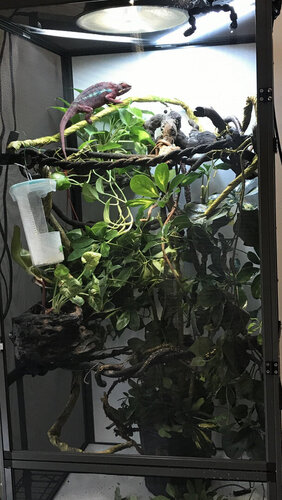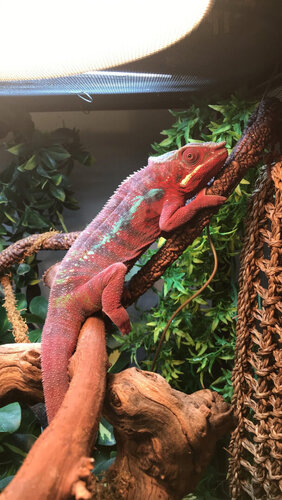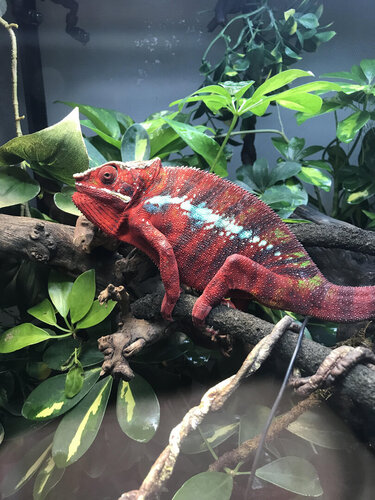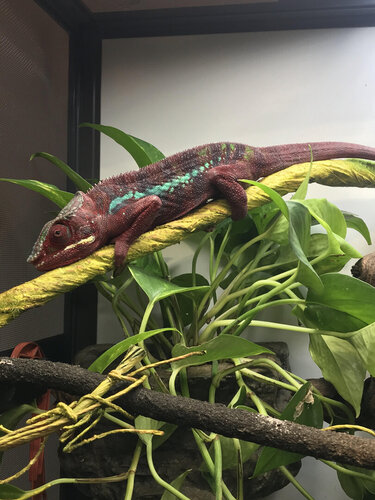IotaPhi936
Member
I have 1.5 year old, captive-bred, male Panther who is relatively active, but he frequently goes to the bottom branches of his cage and hangs out for a few hours (especially late afternoon 4-6pm) and will even occasionally close his eyes for brief periods . I know this is a warning sign that warrants a veterinary visit, but before I take him in, does anyone have any thoughts on this? I feel like he's pretty spoiled!
HUSBANDRY
HOUSING: 24x24x48 inch screen enclosure set up high, next to sliding glass door leading to porch overlooking swampy woodland. I often work at a desk near the enclosure, but he is pretty tame and doesn't appear to alter his behavior when I am there save for scratching the door to tell me I should take him on an "adventure" (sitting on shoulder while I work, hanging out on a makeshift "chameleon chandelier" nearby, or going outside on the porch; outside, he prefers to sun himself on my hand or arm, but usually I'll stick him in his outdoor cage so I don't have to watch him and he can stay out longer). His enclosure has an umbrella tree, two pothos, and a number of intersecting branches with fake vines. Despite this, he still does some screen walking, but it's not incessant.
DAY/NIGHT: 8:30 am to 8:00 pm
DIET: Superworms and crickets on the menu roughly half the time, while the other half he gets discoid roaches, calciworms, hornworms, silkworms, and occasional waxworms. Probably eats around 2-5 bugs a day (varies with sheds, etc.). All meals are dusted (save for the calciworms).
WATER/HUMIDITY: Usually between 60-80% ambient humidity. Pockets of higher humidity are produced at night and early morning by a fogger. Mister goes off a few times at night and early morning, but only enough to create a dew on the leaves in the morning. He gets an 8 minute shower at 2pm and a 12 minute shower at 6:30, followed by a short burst at 8:30 and Midnight. A dripper is also available during the day.***NOTE: He is often dehydrated despite my best efforts.
LIGHTING: Currently has a brand new Arcadia UVB light (I think it's 8%, whatever was recommended for Panthers), a small live-plant light, and a 100 watt UVA bulb
HEATING: 100 watt bulb gets basking spot to the low 90s. Upper part of the cage in the 80s and high 70s while the bottom is at room temperature around 70 degrees. Nights will sometimes drop into the high 60s.
HANDLING: As stated above, he "tells me" when he wants to get out and will usually happily walk right onto my arm, but sometimes he's not feeling it (never had a forced handling session).
IN SUM: He eats well, and is otherwise pretty active. Only potential health/behavior warnings I can identify is occasional dehydration, occasional screen-walking, and a desire to explore outside his cage. Any thoughts?
HUSBANDRY
HOUSING: 24x24x48 inch screen enclosure set up high, next to sliding glass door leading to porch overlooking swampy woodland. I often work at a desk near the enclosure, but he is pretty tame and doesn't appear to alter his behavior when I am there save for scratching the door to tell me I should take him on an "adventure" (sitting on shoulder while I work, hanging out on a makeshift "chameleon chandelier" nearby, or going outside on the porch; outside, he prefers to sun himself on my hand or arm, but usually I'll stick him in his outdoor cage so I don't have to watch him and he can stay out longer). His enclosure has an umbrella tree, two pothos, and a number of intersecting branches with fake vines. Despite this, he still does some screen walking, but it's not incessant.
DAY/NIGHT: 8:30 am to 8:00 pm
DIET: Superworms and crickets on the menu roughly half the time, while the other half he gets discoid roaches, calciworms, hornworms, silkworms, and occasional waxworms. Probably eats around 2-5 bugs a day (varies with sheds, etc.). All meals are dusted (save for the calciworms).
WATER/HUMIDITY: Usually between 60-80% ambient humidity. Pockets of higher humidity are produced at night and early morning by a fogger. Mister goes off a few times at night and early morning, but only enough to create a dew on the leaves in the morning. He gets an 8 minute shower at 2pm and a 12 minute shower at 6:30, followed by a short burst at 8:30 and Midnight. A dripper is also available during the day.***NOTE: He is often dehydrated despite my best efforts.
LIGHTING: Currently has a brand new Arcadia UVB light (I think it's 8%, whatever was recommended for Panthers), a small live-plant light, and a 100 watt UVA bulb
HEATING: 100 watt bulb gets basking spot to the low 90s. Upper part of the cage in the 80s and high 70s while the bottom is at room temperature around 70 degrees. Nights will sometimes drop into the high 60s.
HANDLING: As stated above, he "tells me" when he wants to get out and will usually happily walk right onto my arm, but sometimes he's not feeling it (never had a forced handling session).
IN SUM: He eats well, and is otherwise pretty active. Only potential health/behavior warnings I can identify is occasional dehydration, occasional screen-walking, and a desire to explore outside his cage. Any thoughts?









